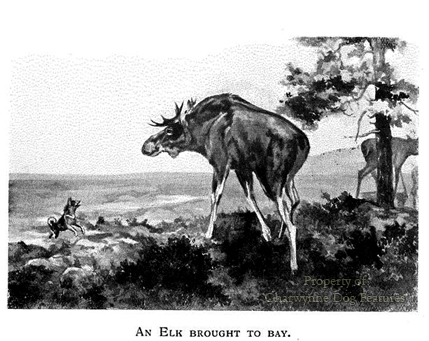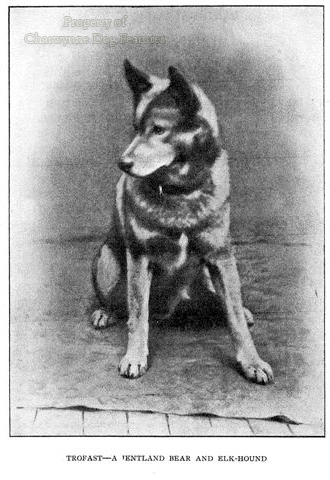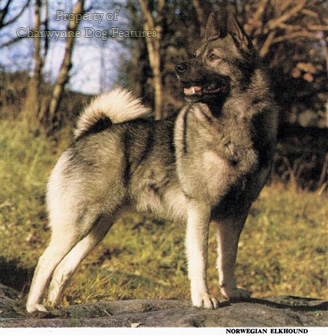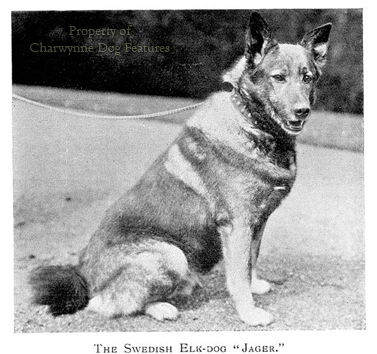768 DOING THE SPITZ
DOING THE SPITZ: THE NORTHERN HUNTING DOGS
by David Hancock
 Books on hounds often overlook the Northern breeds, which can range from the Elkhounds of Scandinavia to the beardogs of Karelia. Somehow the appearance of such hounds, with their prick ears, thick coats and lavishly-curled tails, doesn’t immediately fit our mental image of a scenthound. The Finnish Spitz is already well known here, with 36 newly registered with the Kennel Club in 2010, but only 10 in 2011. They have been grouped with the Hounds by the KC, but as a ‘bark-pointer’ should perhaps be allotted to the Gundog Group. This attractive little breed is a most unusual, for us, that is, hunting dog, in a style not utilised in Western Europe. The dog is used in heavily wooded areas where it uses sight, scent and unusually good hearing to locate feathered game, upland game such as grouse or capercaillie. The location of the quarry is ‘pointed’ by a special stance, four-square with tail up twitching with excitement, head back and giving voice – a distinctive singsong crooning bark, which is sustained, both to mesmerize the prey and attract the hunter.
Books on hounds often overlook the Northern breeds, which can range from the Elkhounds of Scandinavia to the beardogs of Karelia. Somehow the appearance of such hounds, with their prick ears, thick coats and lavishly-curled tails, doesn’t immediately fit our mental image of a scenthound. The Finnish Spitz is already well known here, with 36 newly registered with the Kennel Club in 2010, but only 10 in 2011. They have been grouped with the Hounds by the KC, but as a ‘bark-pointer’ should perhaps be allotted to the Gundog Group. This attractive little breed is a most unusual, for us, that is, hunting dog, in a style not utilised in Western Europe. The dog is used in heavily wooded areas where it uses sight, scent and unusually good hearing to locate feathered game, upland game such as grouse or capercaillie. The location of the quarry is ‘pointed’ by a special stance, four-square with tail up twitching with excitement, head back and giving voice – a distinctive singsong crooning bark, which is sustained, both to mesmerize the prey and attract the hunter. 
This ‘point by bark’ has to be audible to the hunter, who may be some distance away, and more importantly to ‘freeze’ the bird. The Finns claim that the tone of the bark, the agitated almost hypnotic waving of the bushy tail – and even the small white spot on the dog’s chest, hold some kind of fascination for the bird, which watches intently from the relative if temporary safety of its perch. There are similarities here with the flamboyantly-waving tail of the old red decoy dog of East Anglia, used to lure ducks for the hunter. The Finnish Spitz has the same rich rufous, almost red-gold coat, mobile ears and highly inquisitive nature. Just as this breed is the national dog of Finland, so too is the Elkhound that of Norway.
Hounds like the Norwegian Elkhound have been used for centuries to hunt bear, elk, reindeer and the wolf, but it was not until 1877 that they were recognised as a breed there. Only those that qualify in hunting trials may be awarded the full title of champion. This surely has to be the way ahead for all sporting dogs if they are to be retained as such. The Elkhound hunts mainly by scent, working silently to locate its prey, which it then holds or drives towards the hunters. As it doesn’t actually ‘catch and kill’ its quarry, strictly speaking it shouldn’t be classified as a hound. (But under our own Hunting with Dogs Act, aren’t all hounds now gundogs?) Usually a shade of grey, with black tips, a black cousin is found in the Finnmark area, with a shorter coat, looking taller and lighter than the Norwegian breed. I saw some sixty years ago when exploring the Jaeggevarre ice-glacier region; the local hunters called them Sorte Dyrehund - they were leggy and thick-coated, hinting at great robustness and stamina. In Sweden, the Jamthund has the same function but is 4 inches taller. The Swedes also have the White Elkhound, not recognised until 1998, with around a thousand on the registry. Further east, the Russians have their own laika or point-barker hunting dog breeds, with regional differences between the West Siberian from the Northern Urals, the East Siberian, from the huge forests there and the Russo-European varieties.
At World Dog Shows, especially the one held in Helsinki, I have been impressed by them and the imposing Karelian Bear Dog, a sturdy mainly black breed, used for hunting the bear, lynx and elk. Determined, fiercely-independent and immensely resolute, which is hardly surprising when you think of their quarry, they have a very acute sense of smell and superb long-sight, picking up movement at extreme distances. This breed originated in Karelia, a territory stretching from north of St Petersburg to Finland, with the Russian breeders adding Utchak Sheepdog blood for greater resistance to the cold. Twenty two inches high and around 55lbs in weight, they were originally used to hunt elk, then later to hunt bears and large game. They are related to the Russo-European Laika, often being black-coated and with a similar broad head, but easily confused with the hunting dogs from further east: the Western and Eastern Siberian Laikas. These hunting dogs have quite remarkable resistance to low temperatures and their past value to peasant hunters, especially before the arrival of firearms, must have been immense.
Both the bear and the elk are formidable adversaries, with even the baying dogs being regularly killed by them. An elk, or moose in North America, is the largest living deer, about the size of a horse; the bull can have antlers of up to 40 points. The use of dogs for elk-hunting in northern Europe has a long history. It took two forms: one with wide-ranging free-hunting small packs (loshund) and another with dogs on a long leash (lurhund or bandhund) following a trail. The latter demanded close cooperation between dog and handler, to make full use of the wind conditions and not to startle the quarry into hasty retreat. Hunting bears too was not a practice for the fainthearted in times when only primitive weapons were available. Canada had an equivalent to the Karelian Bear Dog, the Tahltan Bear Dog, used by the Tahltan Indians of British Columbia, south of the Yukon and flanked by Alaska. It was used in packs to hunt black and grizzly bears and the lynx. Even more specialist was the Norwegian Lundehund, used to hunt puffins on coastal cliffs. Sweden also boasts a small hunting dog, the Norbottenspets, used in hunting rabbits and hares. It is not always easy to identify these breeds, the climate and the conditions has shaped them and their similarity of form is understandable.
The best known Spitz-hound in Britain is the Norwegian Elkhound, although its fortunes have varied. Ten years ago, 149 were newly registered with our KC; in 2010, just 33. Comments on the entry at championship shows in 2011 by judges of this breed give concern. These range from “Upright shoulders and wide chests accounted for bad front movement and incorrect rear angulation prevented the correct drive from behind” and “…loose elbows and pasterns were evident in most exhibits” to “Hind movement overall was not good, particularly in the males…they were straight in angulation in front and rear and therefore lacked both reach and drive.” This is a breed that relies on endurance and these judges’s criticisms are worrying for the future of the breed here, famous as a working hound. The Elkhounds I have seen in Norway looked stockier and shorter-coupled than those I saw in the United States, where I was saddened to see them lighter and finer-boned – and expected to ‘gait’ at speed in the ring, rather like Siberian Huskies. I don’t think Norwegian elk-hunters would want their precious dogs to perform in such a way!
